With their thick fur, enormous claws, and unique lumbering gait, bears are some of the most iconic creatures on the planet. These large and powerful mammals live in a range of habitats across the globe, residing in areas that range from North America’s dense forests to the icy Arctic tundra. Bears are extremely intelligent and adaptable animals, but only a few call the jungle home. So, let’s take a look at the only bears that live and survive in the jungle!
Bears and Their Unique Habitats
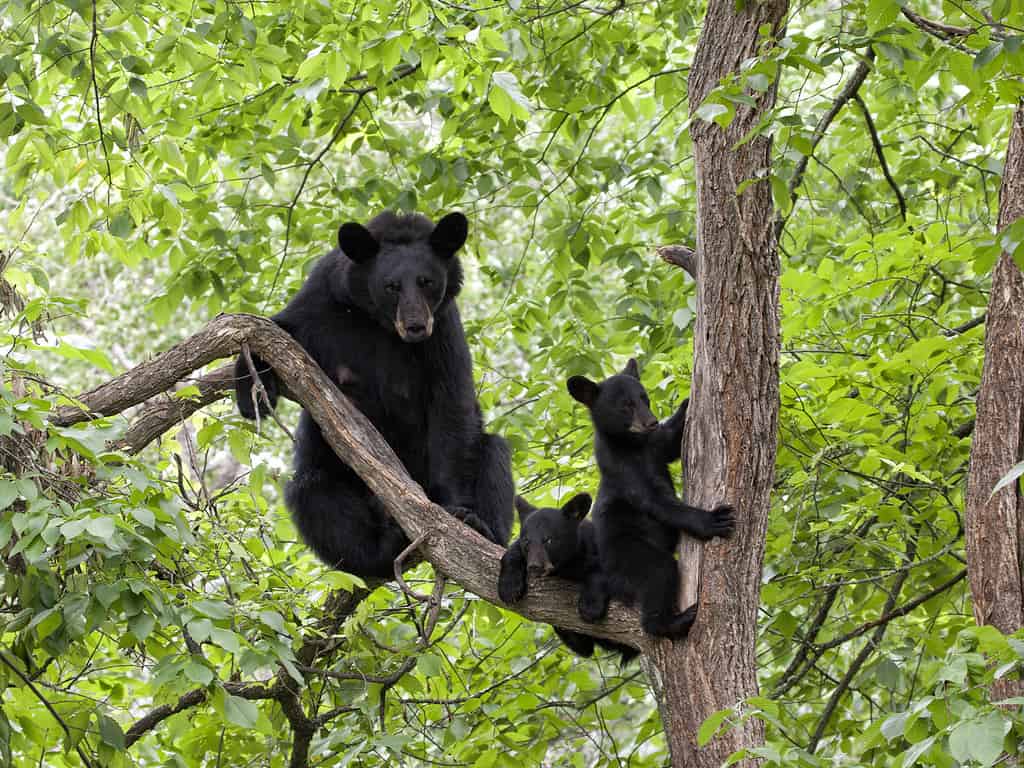
Many bears live in trees, but few live in jungle habitats.
©dssimages/iStock via Getty Images
There are eight species of bears on Earth today that can be found on every continent except Antarctica and Australia. These include:
- American black bears in North America, from Alaska to Mexico
- Brown bears in North America, Europe, and Asia
- Polar bears in Arctic regions
- Asiatic black bears in East and Southeast Asia
- Giant pandas in Central China
- Sloth bears on the Indian subcontinent
- Spectacled bears in South America
- Sun bears in Southeast Asia
Evolving to thrive amongst a tapestry of different habitats, bears can be found in many areas across the globe, from lush forests to majestic mountains, dry deserts, and breathtaking coastal regions. Each species has its own unique characteristics that allow them to live and survive in their specific habitat.
What Is the Difference between a Forest and a Jungle?
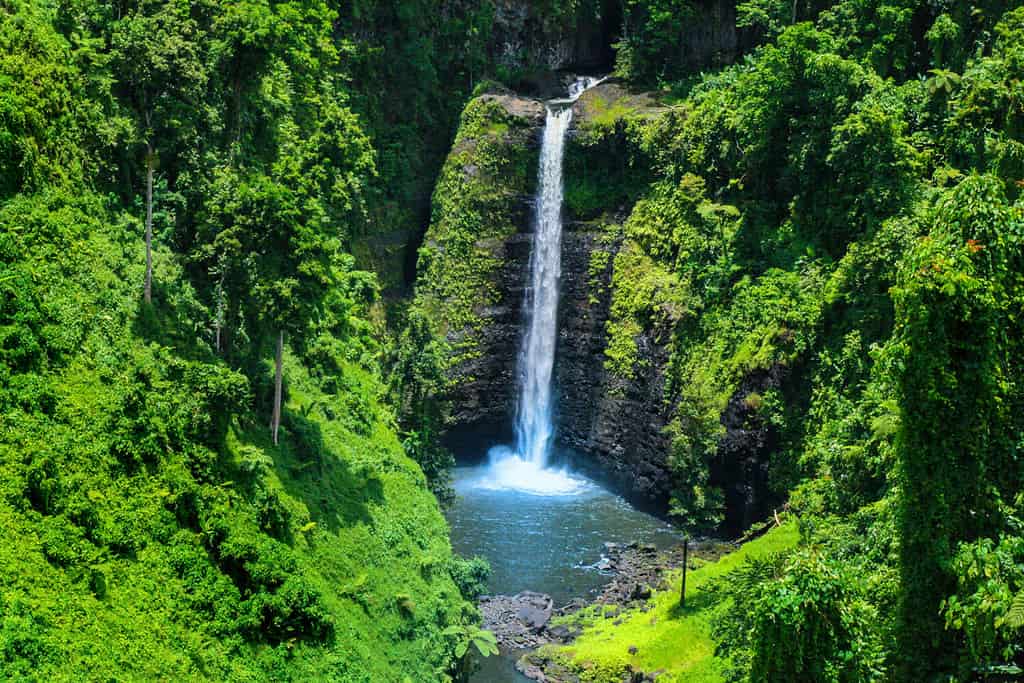
Some jungles are so dense and overgrown that humans cannot travel through them!
©Radoslav Cajkovic/Shutterstock.com
In our casual, everyday speech, we often use the terms “jungle” and “forest” interchangeably. For example, the Amazon rainforest is actually classified as a jungle! However, forests and jungles have many important differences, and not all rainforests are jungles. The temperate rainforests of the Pacific Northwest, for instance, are not classified as jungles.
So, what is the difference between a forest and a jungle? Forests can be found all over the world in many different climates like subtropical, temperate, and boreal, whereas jungles are only found in tropical climates. In addition, forests are not as dense as jungles, although they still have a lot of vegetation covering a large area of land.
A jungle, on the other hand, is much denser than a forest, with lush and tangled vegetation. Some areas may be overgrown and sometimes even impossible to navigate or travel through. Jungles are filled with trees, vines, and all sorts of different plants, providing habitats for many unique creatures that you won’t find anywhere else.
The Main Differences Between a Jungle and a Forest
| Feature | Jungle | Forest |
|---|---|---|
| Location | Typically found only in tropical regions. | Found all over the world |
| Climate | Usually a hot and humid tropical climate. | Can have a variety of climates, including temperate, tropical, and boreal. |
| Vegetation | Dense and tangled vegetation, with a variety of plants and animals, including vines and plants growing on other plants. | Has a variety of trees, shrubs, and other plants, but not as dense as a jungle. |
| Human Access | Can be difficult or impossible to travel through due to dense vegetation. | Can be easy or difficult to travel through, depending on the type of forest. |
While many types of bears may live in forests and along mountain ranges, only a select few live in jungles. Living in the jungle requires many unique adaptations in order to live and navigate in the dense vegetation. In fact, there are only three types of bears that live and survive in jungles: the sun bear, the giant panda, and the spectacled bear.
1. Sun Bears
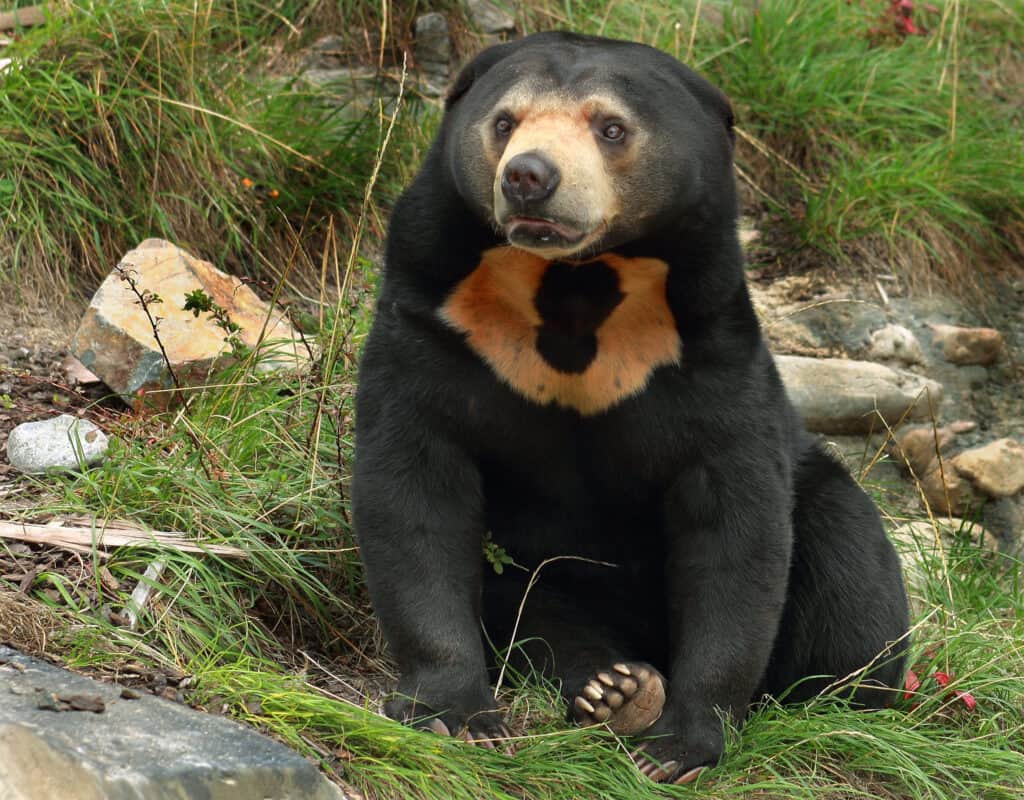
Sun bears are threatened by human activities, including deforestation.
©Molly NZ/Shutterstock.com
The sun bear (Helarctos malayanus) lives and thrives in the tropical forest and jungle habitats of Southeast Asia, including Sumatra, Borneo, and the Malay Peninsula. These beautiful bears get their name from the light-colored crescent marking on their chests, which looks a bit like a rising or setting sun. What is really special about this patch of fur is that it is as unique and individual as a human fingerprint!
The rest of their short and dense fur coat is typically black, but it can vary from shades of gray to more reddish hues. Although they live in hot and humid regions, sun bears have surprisingly thick fur coats. This is actually one of their many unique adaptations to jungle life, as the dense coat protects them from heavy rain, twigs and branches, and helps to cushion them if they fall.
Adaptations for Jungle Life
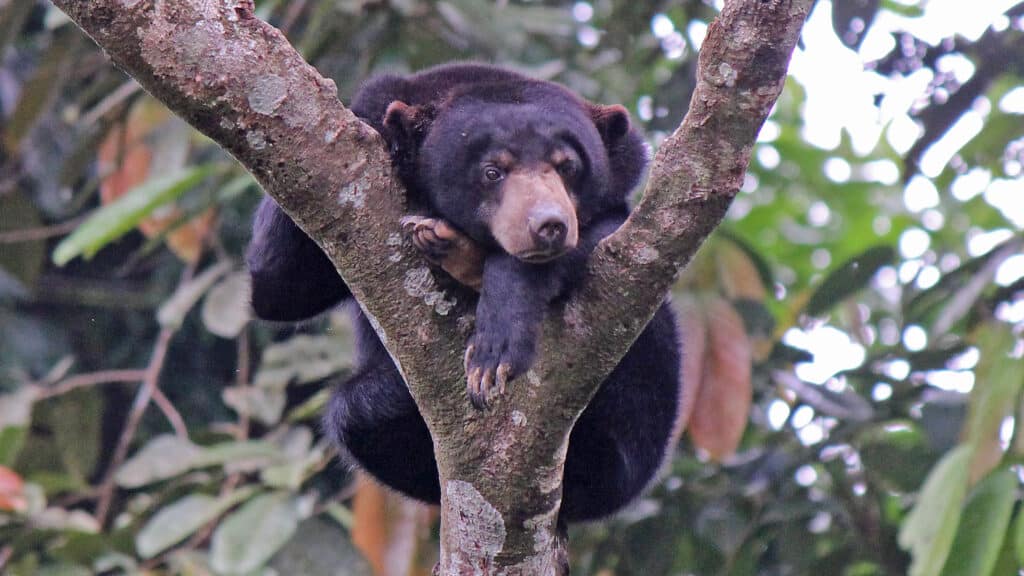
Sun bears commonly take naps on thick tree branches.
©iStock.com/James Moore
Sun bears have many other excellent adaptations that help them live and survive in jungles. For example, the sun bear is actually the smallest species of bear in the world. It is only 28 inches tall at the shoulder and weighs just 55 to 143 pounds (in comparison, a black bear weighs 132 to 660 pounds). This small size allows sun bears to move quickly and navigate the jungle more easily than other bears could.
Sun bears also have stocky bodies, curved claws, and large paws that turn slightly inward, which helps them with climbing. They are arboreal bears and spend most of their time high up in the trees. In fact, sometimes they are called “basindo nan tenggil”, which means “he who likes to sit high” in the Malay language. Sun bears love to hang out in trees and can easily navigate branches, often building nests and enjoying treetop naps.
Sun bears also have an incredible sense of smell, enormous claws, big teeth, and especially strong jaws. In fact, their jaws are so strong that sun bears can even open up tough coconuts! They use their long claws and strong teeth to rip open trees and find sap and insects. Sun bears also have unusually long tongues, which is great for when they want to lap up tasty fruits and honey. Some people even call them “honey bears”!
Unfortunately, sun bears are vulnerable to extinction. Their appetite causes sun bears to get into trouble with humans because they often are drawn to commercial crops like oil palm. In addition, sun bears suffer from habitat loss, poaching, and even the pet trade, with their populations declining more than 30% in the last three decades.
2. Giant Pandas
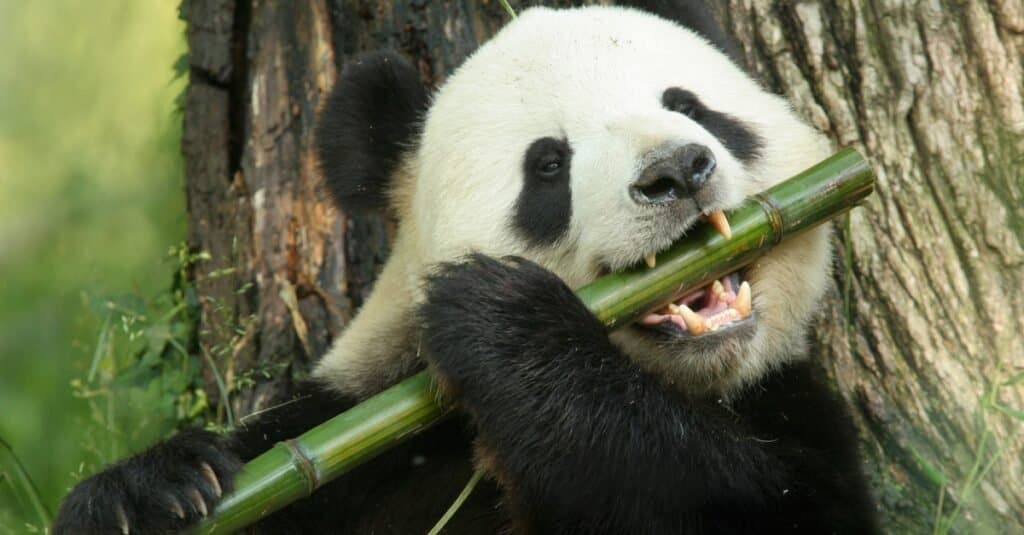
Giant pandas have a false thumb that helps them grip bamboo stalks.
©Bryan Faust/Shutterstock.com
Endemic to China, the giant panda (Ailuropoda melanoleuca) is another bear that lives and survives in jungles. These black and white beauties live in habitats predominantly filled with towering bamboo plants. While bamboo is technically categorized as a type of grass, it can grow to impressive heights and create a dense and jungle-like atmosphere with lush vegetation. These bamboo forests are incredibly important for pandas, not only because they provide shelter but also as a vital food source.
A giant panda’s diet consists almost entirely of bamboo! In fact, pandas spend at least 12 hours every day eating bamboo. They use their teeth to peel off the tough outer layers of bamboo, allowing them to access the delicious soft inner tissue of the stalk. They also have incredibly strong jaws and cheek muscles for crushing and chewing. Giant pandas also enjoy munching on bamboo leaves, expertly stripping them off the stalks, wadding them up, and gobbling them down. Bamboo may be their favorite dish, but giant pandas also can snack on bulbs, grasses, fruits, and even insects.
Adaptations for Jungle Life
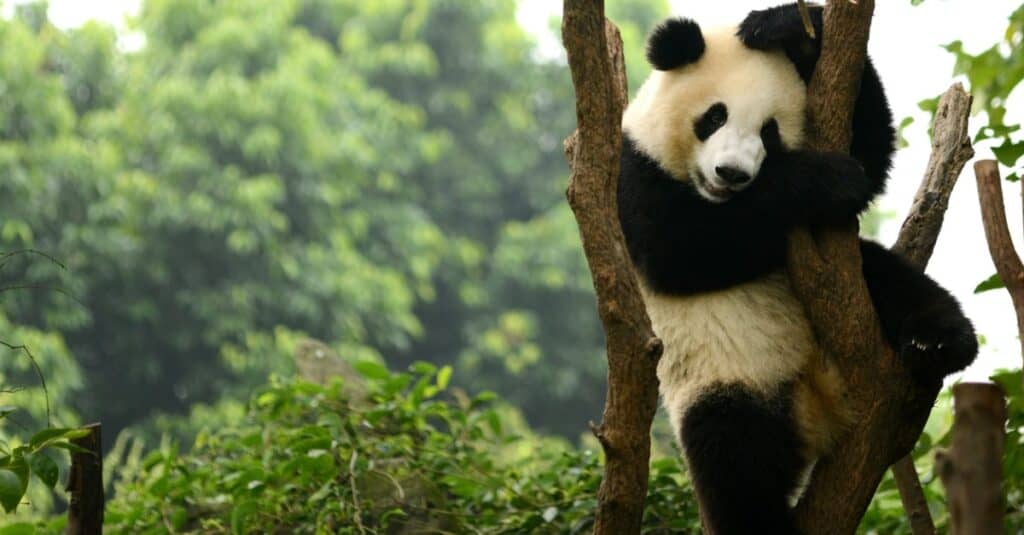
When they are around five months old, baby giant pandas begin developing tree-climbing skills.
©iStock.com/dangdumrong
Giant pandas have a unique feature called a “false thumb”. It is not a real thumb, but rather an enlarged sesamoid bone on the wrist that acts a lot like a thumb. This helps them to grip bamboo stalks and leaves. In addition, pandas have thick wooly fur. In their cool and damp jungle environments, this cozy fur coat protects them and keeps them warm.
Unfortunately, like the sun bear, the giant panda is also vulnerable to extinction and has been a popular target for poachers since ancient times. Giant pandas also suffer from habitat fragmentation and habitat loss, in addition to very low birth rates, bamboo shortages, and stumbling into hunting traps.
3. Spectacled Bears

Spectacled bears mostly live in forest habitats in the northern and central Andes Mountains.
©Andrei Preda/Shutterstock.com
The only bear in South America is the spectacled bear or Andean bear (Tremarctos ornatus), a unique animal well-adapted to living in the jungle. Spectacled bears typically favor cloud forests (or Andean forests) and the páramo (high Andean moorlands), but they can also live in dry regions as well as tropical jungles. Among the world’s many bear species, spectacled bears excel as some of the best climbers. They possess remarkable arboreal skills, frequently choosing to live and sleep high up in the trees. They can scale these heights effortlessly, and occasionally build makeshift platforms to eat or nap in the lush branches above.
Adaptations for Jungle Life
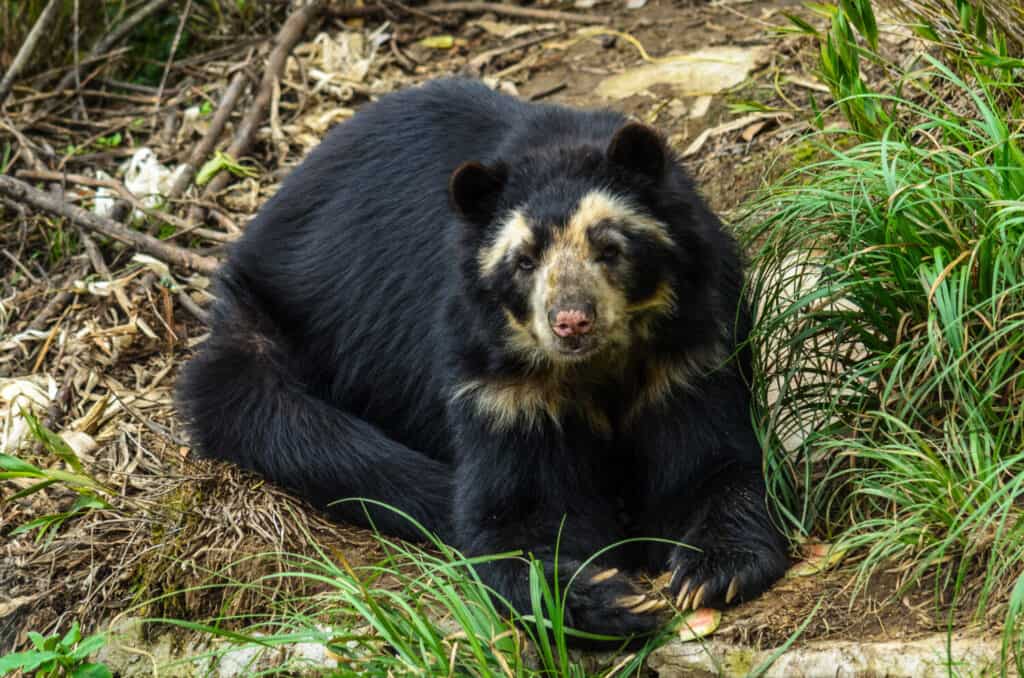
Some spectacled bears have few cream-colored markings, while others have very distinct “spectacles”.
©Danica Chang/Shutterstock.com
Spectacled bears chew through tough plants with their wide, flat molars and extremely strong jaws. They often feed on ripe fruits high up in the trees, as well as plants that grow on the ground. When fruits are scarce, they rely on the fibrous parts of plants like orchid bulbs, the soft parts of palms, bromeliad hearts, and even tree bark. Speckled bears are not picky eaters and may also indulge in birds, insects, and small rodents.
Like sun bears, spectacled bears are a smaller species. They typically grow 24 to 36 inches tall at the shoulder. Females weigh 180 pounds or less and males weigh up to 340 pounds. Their smaller stature is another useful adaptation for jungle life, allowing them to move easily through the dense vegetation.
Spectacled bears get their name from the unique white or cream-colored markings around their eyes, which look a lot like a pair of spectacles or glasses. These markings can extend down to the bear’s throat and chest as well, giving each individual their own unique look. Spectacled bears have thick coats and usually sport colors like black and brown with a few hints of red.
Like the only other bears that live in the jungle, spectacled bears are also vulnerable to extinction. Unfortunately, they also suffer from habitat destruction and fragmentation. In addition, poachers hunt spectacled bears and farmers commonly treat them as pests.
Summary of the Only Bears that Can Live and Survive in the Jungle
| Bear | Location | Special Jungle Adaptations |
|---|---|---|
| Sun Bear (Helarctos malayanus) | Southeast Asia | Thick, dense coat; small bodies; large, curved claws and paws; strong jaws and teeth; very long tongues. |
| Giant Panda (Ailuropoda melanoleuca) | Central China | Sharp teeth; strong jaws and cheek muscles; “false thumb”; thick wooly fur. |
| Spectacled Bear (Tremarctos ornatus) | South America | Wide and flat molars; strong jaws; small bodies. |
The photo featured at the top of this post is © iStock.com/James Moore
Thank you for reading! Have some feedback for us? Contact the AZ Animals editorial team.






